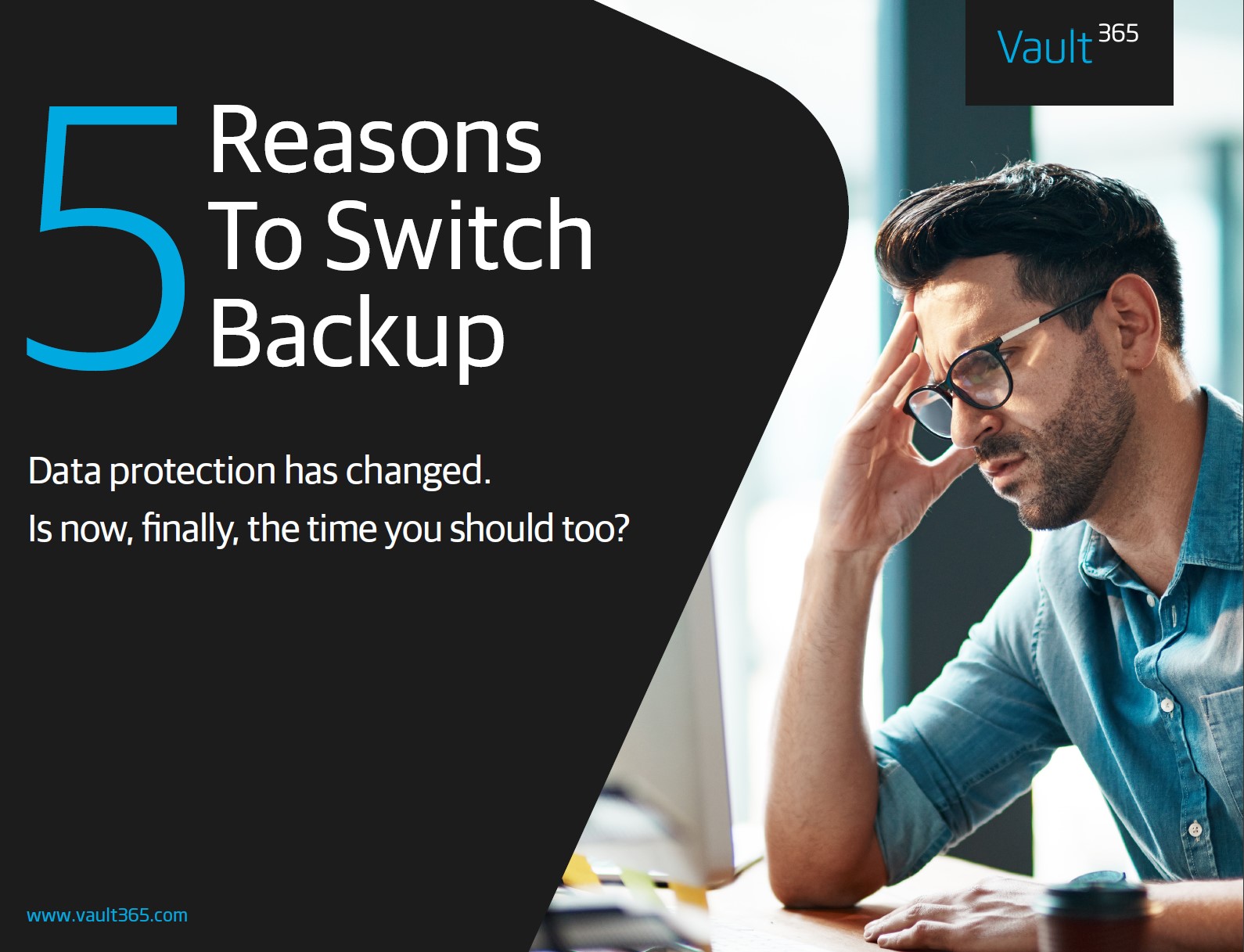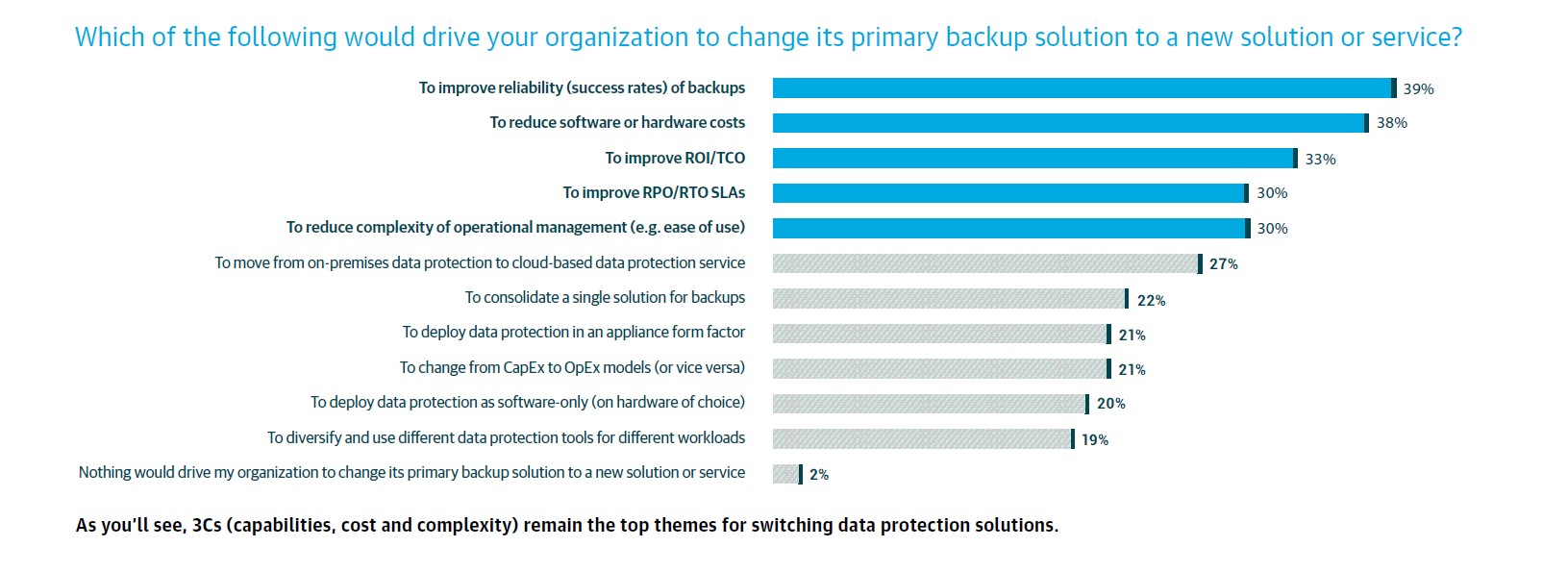
Introduction
By now, our worlds have been completely flipped upside down. But one thing remains the same. Most legacy backup solutions in the market today…well… aren’t very good. Spending too much effort on backup, IT admins lack the time, resources and simply the energy to proactively tackle the real business challenges are holding businesses back and slowing them down. The frustration is real, people!
Here’s some data to prove the point. Between September and December 2020, an independent research company asked 3,000 IT pros from 28 countries about their backup and it turned out that only 63% of backups completed on time without errors and 33% of all restore jobs/tasks fail to be successful. Leaves a bad taste in your mouth, doesn’t it?
These days, IT needs to think not one, but several steps ahead. Taking ransomware, vendor lock-in, storage capacity, cloud mobility, as well as unpredictable world economical and health factors into the equation.
To add a cherry on top, the events of 2020 and now 2021 have compounded these pressures like a match to a tinderbox. From the explosion of remote working, to the increasing sophistication of security attacks, data protection needs to be a priority. Don’t settle for “meh”. You can’t afford to put it off any longer.
If you’re reading this, you can probably attest to some, or maybe even all, of the above. This means you’re likely a victim, I mean customer, of one of those mediocre backup solutions.
It’s OK. Know this: you’re not alone. IT pros around the globe are feeling your pain! This quick read is designed to help you understand the why and when.
Then, the ball is in your court to determine the how.
List of the 5 Reasons
Here is what 1,500 IT pros from around the globe had to say when asked this simple research question:

Another very interesting data point from this question:
Only 2% of respondents claimed, “nothing would drive my organization to change its primary backup solution to a new solution or service”. If 98% of IT pros having a reason to switch doesn’t scream a lack of trust, loyalty and confidence in their current provider, nothing else could!
Reason #1
My current backup is unreliable.
The most popular reason to switch primary backup solutions is reliability or, a lack thereof. This comes from taking 20-year-old code (or even 30 if you can believe it) and attempting to retrofit it for the IT challenges of today. It’s the equivalent of the Winnebago in Spaceballs. Absolutely
ridiculous. (If you’re too you ng to get that joke, Google it, then watch it. That movie is great. And may the Schwartz be with you!)
In addition, dedupe databases often become error prone and can cause complete data loss. Many solutions lack data recovery verification, or only provide this availability for limited platforms (for example, VMware only). Another issue is simply visibility into what is working and what’s not. All too often, IT admins only find out there’s an issue when it’s too late. It’s like discovering a leak in your roof in the middle of a monsoon. Not good.
Many companies chalk this up to lack of training or skills. This is untrue. If a backup solution is stable, reliable and easy to use, then you shouldn’t need a PhD to work it. In addition, many IT pros avoid testing due many reasons, but a modern solution can test your backups on schedule
in an isolated virtual network.
What you should expect from your next backup solution is peace of mind, and a “set it and forget it” type of confidence. You deserve a solution that’s got your back. Plus, imagine actually knowing that you can restore when needed.
Reason #2
Once you add everything up, it costs a lot.
When considering the cost of data protection, it’s easy to focus on the traditional costs — hardware, software and storage. Some hardware costs can come at a premium when you’re locked-in, and your software isn’t flexible enough to handle alternatives. Many software solutions
include add-ons, secondary components or ongoing services so make sure nothing is excluded from your calculation. For storage costs, we all know someone who has been burned with hidden charges and data reduction promises that never quite come to fruition. The days of simply pointing to a target are over. You need to find the right balance between performance and cost efficiency, and the recovery SLAs you’re comfortable with for the cost. Without any “gotchas”. Those are the worst.
Don’t forget the less tangible, often forgotten costs. The cost of downtime and data loss. In addition, impacts that downtime and data loss can have on your relationship with your customers or damage to brand integrity can be quite impactful. The time, effort and resource costs to not only maintain your backup infrastructure, but also to get ramped up, trained
and running at full capacity. Another cost is lost productivity. Few things are more frustrating to an IT pro than when they are wasting time and energy reacting to data protection issues, opposed to proactively working on other important project.
What you should expect from your next backup solution is a simple, yet flexible cost model; where you can use the hardware and storage you want, that can snap in with the software solution you like. You should also be able to make a change in your own environment without setting off a domino-effect nightmare that results in you having to cancel your weekend plans to clean up the mess. This restriction also prohibits your use of modern technologies which perpetuates a long-term effect of reduced efficiency.
Reason #3
That ROI never became a reality.
We’ve all been promised software could do something only to later find out that it couldn’t. Now you’re juggling multiple solutions to cover certain aspects of your environment, or that path to simplicity just became more complex. That ROI calculator you were promised drifted away just like Homer Simpson disappearing into the bushes taking your confidence, budget and reputation with him.
Another ROI consideration for your benefit is data re-use. All data protection solutions encapsulate a great deal of data. In today’s ecosystem, data is power, and the right ROI calculation isn’t simply crunching the numbers of time saved versus money invested, but the value provided by putting your data to work.
What you should expect from your next backup solution (and those that are selling it) is the principle to “under promise and over deliver”. No Sales Engineer demo magic tricks. A software-defined trial experience with YOU in the driver’s seat, available immediately without waiting on an appliance to be delivered and a Systems Engineer to configure it. Maybe you can even find a solution to help you tap into the power of the data gold mine that you’re sitting on. Like adding marshmallow fluff to your peanut butter and banana
sandwich, that extra layer makes all the difference.
Reason #4
My recovery times are slow, and backup windows are long.
Some backup vendors might try to wow you with an example, but when you dig into product breadth — backup configurations, architectural flexibility, snapshot integrations, replication capabilities — reality sets in. It takes time, years really, to build the required breadth.
Another key factor is recovery speeds and flexibility. Often, it’s not a story of if you can recover, but how easily and quickly can you do it. Count the number of clicks it takes you to recover something simply, they may surprise you. Many solutions either lack the granularity for specific recoveries, or the scalability for bulk restores.
But let’s think bigger — what if you can’t tolerate even a few minutes of data being lost in the shortest of backup windows? You need the big guns — continuous data protection (CDP). Many would agree that it’s the best when it comes built-in with your existing backup solution,
operating replicas natively from the same console. However, some vendors still separate CDP as a separately priced product or specialize exclusively on CDP, making you couple it with another product for more regular backup needs.
What you should expect from your next backup solution is a variety of recovery options to satisfy any SLAs, as well as a proven track record of continuous innovation, built on top of a strong foundation of happy customers. Imagine a product release where users are
literally giddy to get their hands-on code versus “let someone else QA it”.
Reason #5
This is taking too much of my time and resources.
With backup software, ease-of-use cannot be understated. So much so that “babysitting a backup” is a thing. Far too many products in this industry are hard to use and complicated. Kind of like the latest craze to substitute every meal with some ridiculous 14-ingredient protein shake. Good grief just eat a cheeseburger! But we digress…
Other solutions can do what you want, but only through scripting or the right level of PowerShell expertise. It doesn’t need to be that hard, and you shouldn’t have to build a workaround. You bought software to do that for you!
Another important factor is that your backup software needs to be able to evolve with you — like those adjustable pants we all secretly wish we were wearing for a big holiday meal. If adding a new NAS device or changing cloud storage requires you to change your data protection strategy, spend time re-educating IT staff or losing sleep about whether or not your IT team has the skills do to it successfully, you’re doing it wrong.
What you should expect from your next backup solution is the gift of time. Time back to work on other priorities, cut out of work early or actually use that vacation time that keeps piling up.
Questions to Consider
- Stability: how often do you encounter stability issues with your current backup solution (bugs, job failures, etc.)?
- Flexibility: what is your backup storage plan for the next three to five years, and how will data growth, cloud mobility and security risks alter that strategy?
- Data reuse: you sit on a gold mine of business data within your backups — how are you putting that data to work for you to solve key business problems?
- Backup/recovery speeds: as business demands for access to data continue to increase, are your RTOs and RPOs getting better, or have they plateaued? Where were they three to five years ago compared to now? Where would you like them to be?
- Ease of use: how much time do you spend babysitting your backups? If that time was cut in half, what would you do with that extra time?
- How is your company doing? What growth has your organization seen in the past month, year or quarter?
Conclusion
By now, hopefully the why should be clear and the when equally so. (Hint: that’s now).
The how is up to you.
At Vault365, we believe our products provide unparalleled backup and recovery and would love for you to take them for a spin.
Our mission is to deliver a modern platform that can cover today’s backup needs, but more importantly can expand and adapt around whatever you’ll need in the future (cloud workloads, cloud mobility, Kubernetes, etc.)


